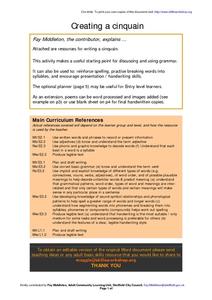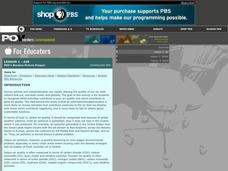Curated OER
How Atoms Work
Students analyze the way atoms function and how they combine to form molecules and various compounds. Using a software program, they create a diagram of an atom and write a summary about their functions. They complete a worksheet and...
Curated OER
Saltwater Science
Students conduct an experiment that shows them how salt water allows things to float. In this salt water lesson plan, students mix ingredients together to create salt water and observe how it makes the oceans dense. They then interpret...
Curated OER
What's That Brown Fuzzy Stuff on My Plum?
Students use Koch's Postulates to determine that a specific organism is the root cause of a specific disease and identify what Koch's Postulates are within a protocol. They describe symptoms and signs of diseased fruit and isolate fungal...
Curated OER
Following Digestion of a Meal
In this digestion worksheet, students review the organs involved in the digestive process along with the function of these organs. This worksheet has 5 fill in the blank, 8 short answer, and 7 matching questions.
Curated OER
Acid, Base, or Salt?
In this acids and bases worksheet, students read about the differences between acids and bases and then complete a table comparing the characteristics of both. Then students determine if the given statements describe an acid, base, or...
Curated OER
Characteristics of Crystals
In this crystals worksheet, students complete a graphic organizer by filling in the characteristics of the different crystal types including melting/boiling point and electrical conductivity.
Curated OER
Composting in Schools: Observing Compost Microorganisms
Students explore composting. In this composting lesson, students use compound microscopes to observe the microbial communities in compost. Observations and documentation of changes will occur over the course of several weeks.
Curated OER
Creating a Cinquain
In this Language Arts worksheet, students read about how to create a cinquain poem. Students read an example and complete a graphic organizer to help guide them in writing their own.
Curated OER
Diversity of Arthropods
In this arthropods worksheet, students will review the characteristics of the different types of arthropods including spiders, ticks, crustaceans, millipedes, and insects. Students will also understand the difference between complete and...
Curated OER
Asking For Help At Local Agencies
Students identify and explore the ways in which businesses, government, and community organizations provided helpful information. A list of local agencies is comprised and students list questions which are appropriate to ask at these...
Curated OER
How Do I Get a Pure Sample of the Molecules I Make?
Learners initially engage in online research and consult print materials to identify a compound to produce. Once a selection has been made, individually, students conduct lab experiments to isolate substances. The end product is a...
Curated OER
Water Molds (Oomycetes)
Students research a group of fungus-like organisms; the Oomycetes, by baiting them from natural sources (water and soil) and observing them.
Curated OER
Periodic History
Students gain a perspective in the development of chemistry. They understand some of the topics in their text and the ongoing nature of research. They then will be able to see the trends of the periodic table first hand through their own...
Curated OER
How Does Matter Change?
In this matter worksheet, students will fill in the blank of 3 statements that show facts about the changes that can happen to matter. Students will then fill in the blank of 1 conclusion statement.
Curated OER
Writing with Style: Six Traits of Good Writers
Fourth graders listen as the teacher reads a picture book that emphasized word choice. They discuss words and how word choice impacts a piece of writing. Students view various passages on the overhead, and highlight adjectives and verbs...
Texas State Energy Conservation Office
Investigation: Blowing in the Wind
Using a simulated air sample, environmental or earth science pupils examine the components. You will need to prepare the faux air by using a hole punch and various colors of construction paper. Each color will represent a different...
Curated OER
P.O.V.'s Borders Picture Project: Lesson 1 - Air
Take photos of human activities that impact air quality. Collaborative groups present one of the photographs, identifying how the activity contributes to air quality and what can be done to minimize the impact. As one in a series of...
Curated OER
Creating a Concept Map
In this concept map instructional activity, students learn the steps of creating a concept map to show the relationship between concepts. Students create a concept mapping using the 5 steps.
Biology Junction
Biochemistry of Cells
Chemistry and biology work hand in hand, without one you literally wouldn't have the other. Using a presentation, individuals learn about plant cells, animal cells, cell responses, macromolecules, DNA bases, and so much more. A worksheet...
National Institute of Open Schooling
Biomolecules
An informative lesson has learners read about, discuss, and study the classification, structure and importance of the following biomolecules: carbohydrates, proteins, lipids, nucleic acids, and enzymes.
Curated OER
Substitution and Elimination Reactions
For this substitution and elimination reactions worksheet, students compete reactions by drawing the structural formulas for 18 reactions. If no reaction occurs, students write N.R.
Curated OER
What Contains Carbon?
Students explore elements by analyzing everyday objects and materials in class. In this carbon lesson, students define several vocabulary terms such as carbon dioxide, hydrocarbon, and carbonate. Students view a group of items,...
California Academy of Science
Carbon Cycle Role Play
Anytime you make concepts clear with role playing or hands-on experience, it's a win for the whole class. Ping-Pong balls are used to represent carbon in a carbon cycle role-play activity. In small groups, children first discuss what...
Curated OER
Cellular Respiration
Students are often confused by the huge amount of information and detail that can be learned about respiration. This is a great presentation summarizing the main 4 stages of cellular respiration. It is clear and uses diagrams and...
Other popular searches
- Naming Organic Compounds
- Organic Compounds of Life
- Test for Organic Compounds
- Organic Compounds Worksheets
- Volatile Organic Compounds
- Organic Compounds in Foods
- Dawing Organic Compounds
- Dwain Organic Compounds























